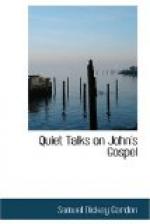The move at God’s end was felt at man’s. The coming down along the highway of the strings thrilled and stirred and awed the hearts into which those strings led, and where they were so tightly knotted. The earth-currents spread the news. Man heard; he felt; he knew: vaguely, blindly, wearily, yet very really he heard and felt and recognized that help, a Friend, some One, was nearing.
And then when Jesus walked among men how He did pull upon their hearts! So quietly He went about. So sympathetically He looked and listened. So warm was the human touch of His hand. So strong was the lift of His arm to ease their load. So potent was the spell of His unfailing power to give relief. How He did pull! And how men did answer to that pull! Unresistingly, eagerly, as weary child in mother’s arms at close of day, they came crowding to Him.
The Fourfold Message.
It is fascinating to find one book in this old Book of God given up wholly to telling of this, John’s Gospel. Of course the whole of the Book is really given up to it, when one gets the whole simple view of it at one glance. But so many of us don’t get that whole simple glance.
So to make it easier for us simple common folk, and to make sure of our getting it, there is one little book, hardly big enough to call a book, just a few pages devoted wholly to letting us see this one thing. You can see the whole of the sun in a single drop of water. You can see the whole of the Book of God in this one little book that John wrote.
John’s Gospel is like the small tracing of the artist’s pen on the lower corner of an etching, the remarque, put there as a signature, the artist’s personal mark that the picture is genuine, the real thing. The whole consummate skill of the artist is revealed at a glance in the simple outline-tracing on the margin. The whole of the God-story in the larger picture of the whole Book is given in few simple clear lines in this exquisite little thing commonly called John’s Gospel.
It is striking to make the discovery that John’s little book has a distinctive message as a book. It is full of messages, of course. But I mean that there is a distinct story told by the book as a whole, by the very way it is put together. It is told by the very sort of language used, the words chosen as the leading words of the book. It is told by the picture that clearly fills John’s eye as he writes, and by the very spirit that floods the pages as a soft light, and that breaks out of them as the subtle fragrance of locust blossoms in the spring.
The fragrance of flowers cannot be analyzed: it must be smelled and felt. That’s the only way you’ll ever know it. The fine scholarly analyses of John are helpful. But there’s the subtler something that cannot be diagramed or analyzed or synthesized. It eludes the razor-edged knife, and the keenly critical survey. It is recognized only by one’s spirit, and then only when the spirit is warm, and in tune with John’s.




